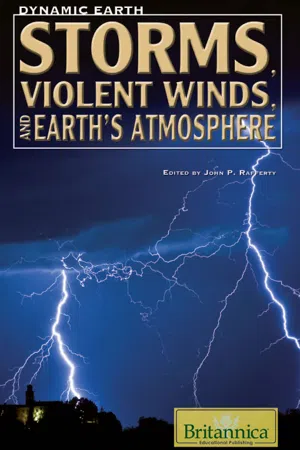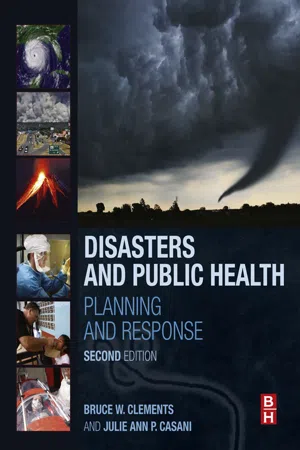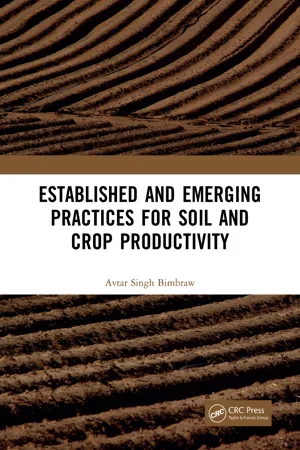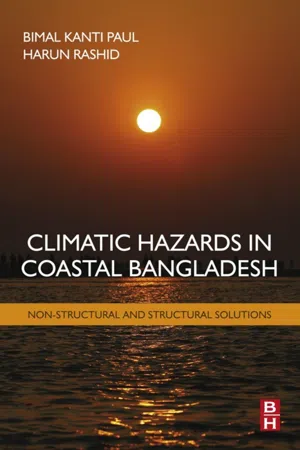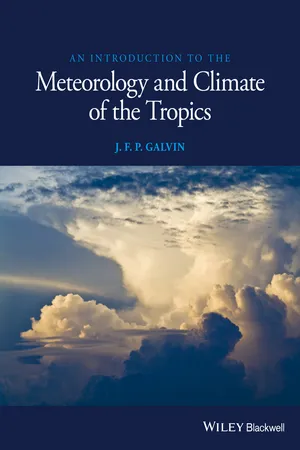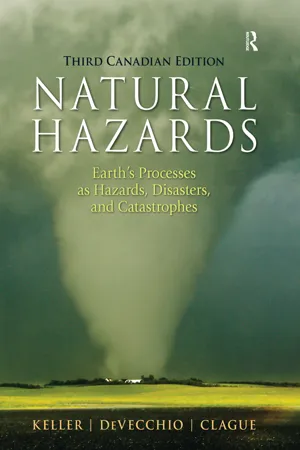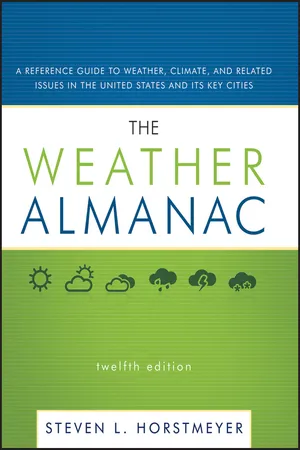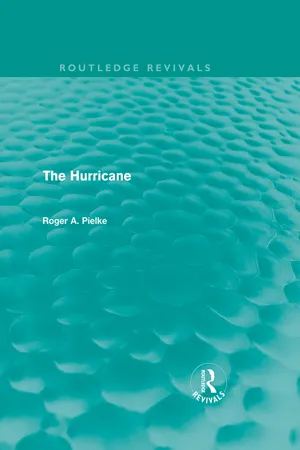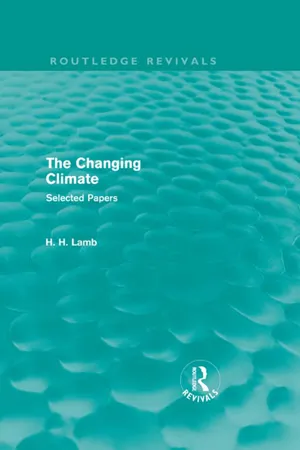Geography
Tropical Storms
Tropical storms are intense weather systems characterized by strong winds and heavy rainfall. They form over warm ocean waters and can cause significant damage to coastal areas through flooding, storm surges, and high winds. These storms are known by different names in different regions, such as hurricanes in the Atlantic and typhoons in the Pacific.
Written by Perlego with AI-assistance
Related key terms
Related key terms
1 of 4
Related key terms
1 of 3
11 Key excerpts on "Tropical Storms"
- eBook - ePub
- Richard A. Davis, Duncan M. Fitzgerald(Authors)
- 2019(Publication Date)
- Wiley(Publisher)
Table 5.2 ). The Florida Keys (including Key West and Key Largo) have survived over 32 hurricanes during the past century, of which seven were major hurricanes.5.4.2 Origin and Movement of Hurricanes
5.4.2.1 Formation
Tropical weather is generally considered to be that occurring between the Tropic of Cancer and the Tropic of Capricorn (23.5 N–23.5 S lat.). Here there is little change in day‐length, seasons are subtle to non‐existent, year‐round temperature is warm to hot, and major changes in weather patterns are linked to the dry and wet seasons. In these latitudes the winds typically blow from the southeast, east, or northeast depending on the latitude. Weather systems of the Tropics, such as hurricanes, are steered by the trade winds, in contrast to those of the mid‐latitudes that move west to east (the Westerlies).The first indication of the potential development of a storm in low latitudes is the presence of a tropical wave. This feature is identified on weather charts as a bending of the streamlines, which show pathways of airflow within the wind system. Tropical waves form over western Africa and move westward into the Atlantic Ocean where they gain strength over the warm water of the tropical latitudes (Figure 5.15 ). The warm water reduces pressure along the wave, transforming it into a trough. In a typical year, about 60 of these develop during the hurricane season – about one every three to four days. They have a wave length of about 2500 km and travel westward with speeds of 10–40 km h−1 . Some of these troughs intensify and develop into tropical disturbances, which is the infancy stage of a tropical cyclone. Tropical disturbances are characterized by a line of thunderstorms that maintain their identity for a day or so. These weather systems have a rotary circulation, counterclockwise in the northern hemisphere and clockwise in the southern hemisphere. Further strengthening of these storms produces a tropical depression, which is a weather system having maximum cyclonic wind velocities up to 61 km h−1 (38 mph). Storms with wind velocities greater than 61 km h−1 but less than 119 km h−1 - eBook - ePub
- Britannica Educational Publishing, John P Rafferty(Authors)
- 2010(Publication Date)
- Britannica Educational Publishing(Publisher)
Chapter 5Tropical Storms AND TROPICAL CYCLONEST ropical storms and tropical cyclones develop in ocean basins charaterized by warm water and easterly waves (that is, regions of weak winds centred around areas of low pressure). Both phenomena form and mature the same way. Tropical cyclones are simply more intense. When tropical cyclones strike populated areas, they often cause great amounts of damage, and the strongest ones are capable of tremendous loss of life.Tropical Storms
Tropical Storms are organized centres of low pressure that originate over warm tropical oceans. The maximum sustained surface winds of Tropical Storms range from 63 to 118 kilometres (39 to 73 miles) per hour. These storms represent an intermediate stage between loosely organized tropical depressions and more intense tropical cyclones. A tropical storm may occur in any of Earth’s ocean basins in which tropical cyclones are found (North Atlantic, northeast Pacific, central Pacific, northwest and southwest Pacific, and Indian). The size and structure of Tropical Storms are similar to those of the more intense and mature tropical cyclones. They possess horizontal dimensions of about 160 kilometres (100 miles) and winds that are highest at the surface but decrease with altitude. The winds typically attain their maximum intensity at approximately 30–50 kilometres (20–30 miles) away from the centre of the circulation, but the distinct eyewall that is a characteristic of mature tropical cyclones is usually absent.The precursors of Tropical Storms in the Atlantic are easterly waves that form over Africa and propagate toward the west. The easterly waves are characterized by wind speeds of approximately 16 kilometres (10 miles) per hour and convective clouds that are loosely organized around a central area of low pressure, or trough axis. The winds transfer heat and moisture from the sea surface to the atmosphere. If local atmospheric conditions support deep convection and low vertical wind shear, the system may become organized and begin to intensify. Intensification occurs as the air warmed at the surface begins to rise. The transfer of air away from the centre of the trough axis causes the surface pressure to fall, which in turn causes higher winds that increase the transfer of heat at the surface. The Coriolis force, which is a product of Earth’s rotation, causes the winds to rotate about the centre, thereby generating a closed and symmetric circulation pattern. - eBook - ePub
Disasters and Public Health
Planning and Response
- Bruce W. Clements, Julie Casani(Authors)
- 2016(Publication Date)
- Butterworth-Heinemann(Publisher)
14Hurricanes, Typhoons, and Tropical Cyclones
Abstract
Hurricanes, typhoons, and tropical cyclones are severe Tropical Storms. Although these storms share common characteristics in formation and impact, the term used is determined by wind speed and location. These storms form over warm water and draw energy from the evaporation of water as they pass over the ocean surface. The storms begin simply as an area of low pressure and thunderstorms called a tropical disturbance. As the warm air causes water to evaporate, it creates lift in the low pressure area. The rising warm, moist air releases energy as it cools and condenses into rain clouds. The process continues building energy in the rainclouds which can erupt into a violent storm encompassing hundreds of square miles. As the winds begin to rotate over the warm water, energy continues to build, eventually creating a hurricane, typhoon, or tropical cyclone. Throughout this chapter, the term “hurricane” will be used. - Avtar Singh Bimbraw(Author)
- 2021(Publication Date)
- CRC Press(Publisher)
8 Causes And Impact Of Hurricanes And Tropical StormsTropical Storms Prone Places
Hurricanes North Atlantic Typhoons Pacific Tropical Cyclones South East Asia Willy-Willies Australia Conditions for formation Tropical Storms
- » Over Oceans
- » Ocean temperature over 27°C
- » Water heated to a depth of several metres
- » Close to the East Coast of continents
- » Late summer or early autumn, when sea temperatures are at their highest (noticed how hurricanes always hit America around September/October!)
Causes of Tropical Storms
- Air on surface of ocean is heated (it also contains lots of moisture)
- Hot, humid air raises, cools and condenses. Clouds form.
- Rising air creates low pressure. Air rushes in to fill gap left by rising air.
- Rotation of the earth means winds do not blow straight. Winds circle towards the centre.
- The storm continues to feed itself.
- Whole system moves westwards towards land.
- When the system crosses the land it loses its source of heat and moisture. The tropical storm losses its energy and dies out.
Difference between tropical disturbance, tropical depression, tropical Storm and hurricane
- » A tropical disturbance is a discrete weather system of apparently organized convection, originating in the tropics or subtropics and existing for a period of over 24 hours. Disturbances are characteristically approximately 200-600 km in diameter.
- » A tropical depression is a tropical cyclone displaying a closed circulation pattern, in which the maximum sustained wind speed reaches up to but does not exceed 17m/s.
- » A tropical Sstorm is also a tropical cyclone, but with faster winds speeds. Tropical cyclones are classified as Tropical Storms when the maximum sustained surface wind speed ranges between 17.5 and 32.5 m/s.
- » A hurricane
- eBook - ePub
Climatic Hazards in Coastal Bangladesh
Non-Structural and Structural Solutions
- Bimal Paul, Harun Rashid(Authors)
- 2016(Publication Date)
- Butterworth-Heinemann(Publisher)
Chapter TwoTropical Cyclones and Storm Surges
Abstract
A cyclone is a low pressure system of the atmosphere in which air pressure has dropped below the standard (normal) atmospheric pressure and winds rotate inward in a counter-clockwise direction in the northern hemisphere and clockwise direction in the southern hemisphere. Storm surges, one of the most devastating hydrodynamic features of tropical oceans, strike low-lying coastal areas, often with great losses of human lives. Cyclone fatalities of epic proportions, widespread property damage, personal injuries, and displacements from homes resulting from destructive powers of super-cyclones in coastal Bangladesh can now be attributed to global warming, increases in sea surface temperatures, and ongoing sea level rise. This chapter gives a brief review of the preconditions for cyclone formation that may provide some insights into the genesis of a severe storm system.Keywords
Coriolis effect; Cyclone; Global warming; Sea surface temperature; Storm surge; Super-cycloneMeaning of Cyclones and Their Alternative Terms
A cyclone is a low pressure system of the atmosphere in which air pressure has dropped below the standard (normal) atmospheric pressure (1013.2 millibar or hectopascal, short-formed as mb or hpa) and winds rotate inward in a counter-clockwise direction in the northern hemisphere and clockwise direction in the southern hemisphere. In meteorological terms, any low-pressure system may be characterized as a cyclone. Therefore, a distinction should be made between two different types of cyclones:• Mid-latitude cyclones , also called frontal cyclones , are large traveling low-pressure systems that develop along weather fronts (lines of separation between a cold air mass and a warm air mass) in the mid-latitudes (35°–55° N and S). Most of them develop as weak low-pressure systems with pressure values barely below the standard atmospheric pressure. Only in exceptional cases, an intense mid-latitude cyclone may have a surface pressure as low as 970 - J. F. P. Galvin(Author)
- 2016(Publication Date)
- Wiley-Blackwell(Publisher)
–1 or more is called a typhoon.Tropical depressions deepen most commonly over the north-west Pacific (mostly between March and December), south Indian Ocean (between November and April), the north-east Pacific, North Atlantic and Caribbean (between June and November), and the south-west Pacific (between December and April). Fewer depressions occur over the north Indian Ocean (rarely during the south-west monsoon and during the change of monsoon circulation). No tropical revolving storms form in the south-east Pacific, where sea-surface temperatures (SSTs) are always too low. The need for a very warm water source is evidently crucial, as can be seen by the rapid dissolution of these storms as they run ashore, even when temperatures are high over land. The immense constant supply of latent heat from a warm ocean surface provides the energy to develop and then maintain the storm as long as it remains over water.The heat, humidity and associated convection of tropical revolving storms lift the freezing level locally, typically to more than 5500 m in the area immediately around and above the eye. In this area, the –20°C isotherm (the level at which icing in cloud becomes less significant) rises above 9500 m (Fig. 9.2 ). The widespread convection warms the troposphere, which expands, creating an upper high above the storm, the tropopause often lifting above 17 km. As a result, cirrus and cirrostratus clouds rotate anti-cyclonically away from the dome at the centre of the storm – see, for example, Fig. 9.3 . Occasionally, the anti-cyclonic circulation around this high may generate winds of jet-stream strength.Cross-section of a mature typical tropical revolving storm. The effect of vigorous convection on the freezing level ( ), 500 hPa height ( ), –20°C isotherm ( ) and tropopause height ( ) can be seen easily. Cloud types: Cb, cumulonimbus; Cu, cumulus; Sc, stratocumulus; Ac, altocumulus; As, altostratus; Cs, cirrostratus; Ci, cirrus. The division between cyclonic and anticyclonic rotation is indicated by . Only within the area do wind strengths reach more than 17 m s–1Figure 9.2- eBook - ePub
Natural Hazards
Earth's Processes as Hazards, Disasters, and Catastrophes
- Edward Keller, Duane DeVecchio, John Clague(Authors)
- 2016(Publication Date)
- Routledge(Publisher)
7 Hurricanes require tremendous amounts of energy, which they acquire from rising warm moist air that condenses at altitude. They form only in oceans that are warmer than 26°C.Most hurricanes start out as a tropical disturbance , which is a large area of unsettled weather that is typically 200 to 600 km in diameter, has organized thunderstorms, and persists for more than 24 hours. A tropical disturbance is associated with an elongated area of low pressure called a trough . Air in the disturbance rotates weakly because of the Coriolis effect (see A Closer Look in Chapter 10 ).Tropical disturbances form in a variety of ways—along lines of convergence similar to squall lines, in upper-level troughs of low pressure, from remnants of cold fronts, and from easterly waves of converging and diverging winds that develop in the tropics. In the Atlantic Ocean, most tropical cyclones develop from easterly waves that form over western Africa.A tropical disturbance may develop into a tropical depression if winds increase and rotate around the area of disturbed weather. Warm moist air is drawn into the depression and begins to spin faster, much as spinning ice skaters increase their rate of rotation by bringing in their arms. Once maximum sustained wind speeds reach 63 km/h, the depression is upgraded to a tropical storm and receives a name. Although the winds are not as strong in Tropical Storms as in hurricanes, the rainfall amounts can be as large. If the winds continue to increase, a tropical storm may become a hurricane.Figure 11.5Cross-Section of a Hurricane The cloudless eye of a hurricane is surrounded by upward-spiralling winds and rain. Warm, moist air at the surface spirals toward the centre of the storm and rises to form rain bands. Sinking dry air creates spaces with fewer clouds between the bands. The innermost rain band is the eyewall cloud that surrounds the centre of the storm. Rising warm air from the eyewall either leaves the storm in one of several outflow jets aloft or loses moisture and sinks back into the eye of the storm. Subsiding dry air in the eye warms by compression, giving the storm its characteristic warm core. The vertical dimension of this diagram is greatly exaggerated. (NOAA) - eBook - ePub
The Weather Almanac
A Reference Guide to Weather, Climate, and Related Issues in the United States and Its Key Cities
- Steven L. Horstmeyer(Author)
- 2011(Publication Date)
- Wiley(Publisher)
Once a complex of thunderstorms begins to rotate and the central pressure drops, if conditions are right, the winds increase and the pressure continues to fall. In the Atlantic Ocean the complex becomes a tropical depression; after additional strengthening the depression becomes a tropical storm and then a hurricane.Because of the release of latent heat by condensing water vapor within the storm and warming of sinking air by compression in the eye tropical cyclones are classified as warm-core disturbances.Figure 5.7 shows all tropical cyclone occurrences on Earth from 1985 to 2005 along with the name used to commonly refer to hurricane-strength storms. Table 5.1 gives the regional names at various levels of organization and development, while Table 5.2 indicates the seasons and average storm numbers.Figure 5.7 Worldwide distribution of tropical cyclones with regional names. (Source: NASA.)The tropical South Atlantic is a special case. Only one tropical cyclone is known to have ever reached tropical storm or hurricane strength there (Figure 5.8 ), while a total of only six tropical cyclones are known. Two additional storms classified as subTropical Storms, which have both tropical (deep convective thunderstorms) and middle-latitude characteristics (cool air pool aloft), have formed in the South Atlantic. In Figure 5.8 note that the circulation of Catarina is the opposite of a northern hemisphere tropical cyclone. Just before this chapter was finished, the second known tropical storm strength cyclone was spotted by satellite off the coast of South America. Storm 90Q is shown in Figure 5.9 . The arrow points to 90Q in the visible satellite image. No eye is visible, but 15 hours later, an infrared image from another satellite (inset) shows big thunderstorms near the storm's center and the evidence of an eyelike feature.Many speculate that between South America and Africa the water is too cool for tropical cyclone formation. That may be true at times as the cool water that wells up off the west coast of Africa flows toward South America, south of the equator. But the controlling factors are that vertical wind shear through the atmosphere is too strong in the region and there are few disturbances there to initiate tropical cyclone formation. - eBook - ePub
- Roger A Pielke(Author)
- 2013(Publication Date)
- Routledge(Publisher)
Figure 1.7 schematically shows how such a presentation would appear for a storm that evolves from a tropical storm (at time 0) to a hurricane level 2 (at time 36 hrs).Figure 1.7 Use of the Saffir/Simpson scale to delineate storm intensityIt is important to note two major observed characteristics of tropical cyclones as displayed in Figure 1.7 .Relation of Tropical Cyclones to the General Circulation of the Earth In order to understand why tropical cyclones form where and when they do, an understanding of the general circulation of the earth is required.• The area of damaging winds extends well beyond the point location of hurricane position that is displayed in Figures 1.3(a) –(g) and 1.4(a) –(l) and Appendix A .• the area of most destruction is concentrated close to the eye of the storm.The primary driving force on the earth’s atmosphere is the amount and distribution of solar radiation which impinges on the planet. The orbit of the earth around the sun is an ellipse, with an apogee (closest approach) of 1.47 × 108 km (8.0 × 107 nautical miles) in early January and a perigee (furthest distance) of 1.52 × 108 km (8.2 × 107 nautical miles) in early July. The time between the autumnal equinox and the following vernal equinox in the northern hemisphere (about 22 September – about 21 March) is approximately one week shorter than the remainder of the year, as a result of the earth’s elliptical orbit, resulting in shorter winters in the northern hemisphere than south of the equator.The earth rotates every 24 hours around an axis that is tilted at an angle of 23.5° with respect to the plane of its orbit. As a result of this tilt, during the summer season in either the northern or southern hemisphere, sunshine is more direct on a flat surface at a given latitude than it is during the winter season. Poleward of 66.5° of latitude, the tilt of the earth is such that, for at least one complete day (at 66.5°) and for as long as six months (at 90°), the sun is above the horizon during the summer season and below the horizon during the winter. - eBook - ePub
The Changing Climate (Routledge Revivals)
Selected Papers
- Hubert H. Lamb(Author)
- 2013(Publication Date)
- Routledge(Publisher)
The Intertropical Zone or Meteorological Equator . Between the subtropical anticyclone belts the Trade Winds, mainly from NE and SE in the northern and southern hemispheres respectively, meet in a zone of rather lower pressure. Convergence in this zone is associated with large scale ascent of air giving rise to great cloudiness (through adiabatic expansion leading to temperature fall and condensation) and equatorial rains. The rainfall is characteristically heavier than in the frontal rains of the subpolar depressions because of the greater water content of warm equatorial air and because of the strong vertical lapse rate of temperature which encourages vertical motion.The intensity of the Trade Winds and of the equatorial rains seems to be related to the intensity of the subtropical anticyclones; hence they ultimately depend upon the prevailing strength of the circumpolar westerlies and the main poleward temperature gradient in either hemisphere.Riehl54 has pointed out that the intensity of the Trade Winds probably reacts upon the over-all intensity of the general circulation. The prevailing strength of the Trades is close to the critical speed for smooth or rough sea surface: so small changes in the average strength of the Trades might make a big difference to the amount of evaporation; and, since moisture in the atmosphere represents potential energy (through the latent heat of condensation), this might materially increase or decrease the vigour of the entire atmospheric circulation.Tropical cyclones (hurricanes, typhoons) are a class of short-lived (3–10 days) disturbances of great violence which develop occasionally in the tropics when special conditions are satisfied.7 They only form over the oceans and where the zone of intertropical convergence has become far enough displaced from the geographical equator for the Coriolis acceleration (the 2 ω. V - eBook - ePub
Exploring Natural Hazards
A Case Study Approach
- Darius Bartlett, Ramesh Singh(Authors)
- 2018(Publication Date)
- Chapman and Hall/CRC(Publisher)
1 Tropical Cyclone and Track ForecastingChandan Roy and Rita Kovordanyi1.1 Introduction1.2 Tropical Cyclone (TC) Formation1.2.1 Factors Affecting TC Formation1.2.1.1 TC Formation1.2.2 Theories of Cyclone Formation1.2.2.1 Conditional Instability Theory1.2.2.2 Air–Sea Interaction Theory1.2.2.3 Eddy Angular Momentum Theory1.2.2.4 Latent Heat Release Theory1.2.3 Cyclone Formation Basins and Their Characteristics1.2.4 Life Cycle of a Tropical Cyclone1.3 Tropical Cyclone Structure1.3.1 Cyclone Eye and Eyewall1.3.2 Spiral Cloud Bands1.3.2.1 Theories of Cloud Band Formation1.4 Tropical Cyclone Motion1.5 TC Track Forecasting Techniques1.5.1 Predictor Selection and Use1.5.1.1 Techniques Using Recent Past Track and Climatological Data (Historical Cyclone Track Data) as Predictors1.5.1.2 Techniques Using Steering Information as Predictors1.5.1.3 Techniques Using Both Historical and Steering Information as Predictors1.5.1.4 Techniques Using Satellite-Derived Information as Predictors1.5.2 Equation-System Use1.5.2.1 Techniques Using Statistical Equations1.5.2.2 Techniques Using Fluid Dynamics and Thermodynamics Equations1.5.2.3 Techniques Using a Combination of Mathematical and Statistical Equations1.5.2.4 Techniques Using Other Types of Equations1.5.3 Prediction Length and Performance1.5.4 Computational Resource Requirements1.6 ConclusionsReferences1.1 IntroductionTropical cyclones (TCs), also known as hurricanes or typhoons, are among the most remarkable and deadliest meteorological phenomena. TCs are unique among all meteorological disasters because of their capacity to create both strong up-shore winds and high storm surges. In addition to these characteristics, TCs are well known for their ability to cause substantial property damage and human casualty. If we rank historical meteorological disasters (disasters that occurred during the period 1900–2011) based on inflicted human casualty and property damage, the historically largest TCs occupy positions 1 through 10 in both of these aspects. These 10 most lethal and most destructive meteorological disasters killed nearly 1 million people and caused $281,800 million in property damage.
Index pages curate the most relevant extracts from our library of academic textbooks. They’ve been created using an in-house natural language model (NLM), each adding context and meaning to key research topics.
Explore more topic indexes
Explore more topic indexes
1 of 6
Explore more topic indexes
1 of 4

